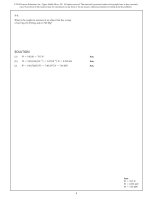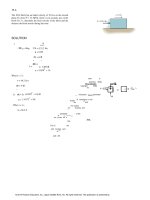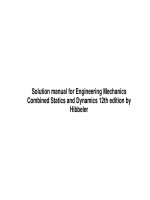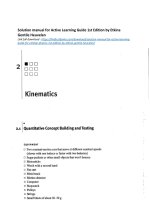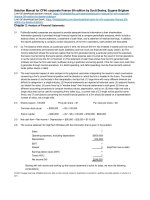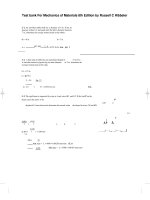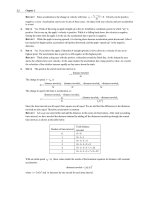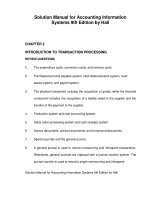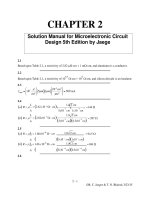Solution manual for engineering mechanics dynamics 13th edition by russell c hibbeler
Bạn đang xem bản rút gọn của tài liệu. Xem và tải ngay bản đầy đủ của tài liệu tại đây (16.43 MB, 254 trang )
z
link full downoad
/>
F
2
y
F
3
13–1.
The 6-lb particle is subjected to
the action of
its weight and forces
F1 = 52i + 6j - 2tk6 lb,
F2 =
2
5t i - 4tj - 1k6 lb,
and F3 = 5 - 2ti6 lb, where t is in
seconds. Determine the distance the ball is from the origin 2 s
after being released from rest.
x
SOLUTION
©F = ma;
6
2
(2i + 6j - 2tk) + (t i - 4tj - 1k) - 2ti - 6k = ¢32
.2 ≤(axi + ay j + azk)
Equating components:
6
6
2
6
¢ 32.2 ≤ax = t - 2t + 2 ¢ 32.2 ≤ay = - 4t + 6 ¢ 32.2 ≤az = - 2t - 7
Since dv = a dt, integrating from n = 0, t = 0, yields
t
6
3
6
2
2
¢ 32.2 ≤vx = 3 - t + 2t
¢32.2 ≤
s =
x
12
-
3
6
2
¢ 32.2 ≤vy = - 2t + 6t
¢32.2 ≤
+t
¢ 32.2 ≤vz = - t
¢
s
y
= -3
+ 3t
Since ds = v dt, integrating from s = 0, t = 0 yields
6
4
3
t
instructors
6
sx = 14.31 ft,
sy = 35.78 ft
sz
World
learning
= 89.44of
ft
United
the is not
on
use
s=
(14.31)2
+ (35.78)2
permitted
2
States
When t = 2 s then,
for
+ ( - 89.44)2 = 97.4 ft
by
Thus,
student
the
protected
of the
assessing
is
solely
work
work provided and of
This is
their
des troy
sale will
integrity
this
the
and courses part
any
of
or
Web)
2.
32.2 ≤sz = - 3 - Dissemination
copyright
Wide
2t
2
laws
teaching
3
6
t
- 7t
work
and
Ans.
.
F1
© 2013 Pearson Education, Inc., Upper Saddle River, NJ. All rights reserved. This publication is protected by
Copyright and written permission should be obtained from the publisher prior to any prohibited reproduction, storage in a retrieval system,
or transmission in any form or by any means, electronic, mechanical,
photocopying, recording, or likewise. For information regarding permission(s), write to:
Rights and Permissions Department, Pearson Education, Inc., Upper Saddle River, NJ 07458.
13–2.
v = 10 ft/s
The 10-lb block has an initial velocity of 10 ft>s on the smooth
plane. If a force F = 12.5t2 lb, where t is in seconds, acts on the
block for 3 s, determine the final velocity of the block and the
distance the block travels during this time.
F = (2.5t) lb
SOLUTION
10
+
2.5t = ¢ 32.2 ≤a
: ©Fx = max;
a = 8.05t
dv = a dt
n
L10
t
dv =
L0 8.05t dt
2
v = 4.025t + 10
When t = 3 s,
laws
v = 46.2 ft>s
teaching Web)
.Dissemination
copyright
Wide
A s.
.
ds = v dt
s
or
t
2
L0 ds = L0 (4.025t + 10) dt
States
3
s = 1.3417t + 10t
United
use
When t = 3 s,
for
instructors World permitted
of learning the is not
on
and
the student
(including work
by
s = 66.2 ft
protected
is
of the
assessing
solely
work
work provided and of
integri ty
this
This is
Ans.
the
and courses part
any
of
their
des troy
sale will
© 2013 Pearson Education, Inc., Upper Saddle River, NJ. All rights reserved. This publication is protected by
Copyright and written permission should be obtained from the publisher prior to any prohibited reproduction, storage in a retrieval system,
or transmission in any form or by any means, electronic, mechanical,
photocopying, recording, or likewise. For information regarding permission(s), write to:
Rights and Permissions Department, Pearson Education, Inc., Upper Saddle River, NJ 07458.
13–3.
P
If the coefficient of kinetic friction between the 50-kg crate and
the ground is mk = 0.3, determine the distance the crate travels
and its velocity when t = 3 s. The crate starts from rest, and P =
200 N.
308
SOLUTION
Free-Body Diagram: The kinetic friction Ff = mkN is directed to the left to oppose the
motion of the crate which is to the right, Fig. a.
Equations of Motion: Here, ay = 0. Thus,
+ c ©Fy = 0;
N - 50(9.81) + 200 sin 30° = 0
N = 390.5 N
+
: ©Fx = max;
200 cos 30° - 0.3(390.5) = 50a
2
a = 1.121 m>s
Kinematics: Since the acceleration a of the crate is constant,
+
laws
:B
A
v = v0 + act
teaching
v = 0 + 1.121(3) = 3.36 m>s
s = s0 + v0t +
:
A
1
act
2
B
instructors
of
2
the
learning
Uniteduse
1
s=
Web)
.
copyrightAns. Wide
Dissemination
.
States
World permitted
and
+
or
on
by
2
0 + 0 + 2 (1.121) A3 B = 5.04 m
the student work
(including
protected
of the
is
solely
work
assessing
this
not
is
and
Ans.
for
workprovided and of integrity
This is
the
and courses part
of
their
destroy
any
sale will
© 2013 Pearson Education, Inc., Upper Saddle River, NJ. All rights reserved. This publication is protected by
Copyright and written permission should be obtained from the publisher prior to any prohibited reproduction, storage in a retrieval system,
or transmission in any form or by any means, electronic, mechanical,
photocopying, recording, or likewise. For information regarding permission(s), write to:
Rights and Permissions Department, Pearson Education, Inc., Upper Saddle River, NJ 07458.
*13–4.
P
If the 50-kg crate starts from rest and achieves a velocity of v =
4 m>s when it travels a distance of 5 m to the right, determine
the magnitude of force P acting on the crate. The coefficient of
kinetic friction between the crate and the ground is mk = 0.3.
308
SOLUTION
Kinematics: The acceleration a of the crate will be determined first since its motion is
known.
:
+
( )
2 =
v
2 +
-
v0
2
2ac(s
s0)
2
4 = 0 + 2a(5 - 0) a =
2
1.60 m>s :
Free-Body Diagram: Here, the kinetic friction Ff = mkN = 0.3N is required to be directed
to the left to oppose the motion of the crate which is to the right, Fig. a.
Equations of Motion:
+ c ©Fy = may;
N + P sin 30° - 50(9.81) = 50(0)
laws
teaching
N = 490.5 - 0.5P
or
Web)
.
copyright
Wide
Dissemination
Using the results of N and a,
.
+
: ©Fx
States
= max;
P cos 30° - 0.3(490.5 - 0.5P)
United
P = 224 N
World permitted
not
of learning the is
on andAns.
instructors
= 50(1.60)
use
by
the student
(including work
protected
of the
is
solely
work
assessing
this
for
workprovided and of integrity
This is
the
and courses part
of
their
destroy
any
sale will
© 2013 Pearson Education, Inc., Upper Saddle River, NJ. All rights reserved. This publication is protected by
Copyright and written permission should be obtained from the publisher prior to any prohibited reproduction, storage in a retrieval system,
or transmission in any form or by any means, electronic, mechanical,
photocopying, recording, or likewise. For information regarding permission(s), write to:
Rights and Permissions Department, Pearson Education, Inc., Upper Saddle River, NJ 07458.
13–5.
The water-park ride consists of an 800-lb sled which slides
from rest down the incline and then into the pool. If the
frictional resistance on the incline is Fr
= 30 lb, and in
the pool for a short distance Fr
= 80 lb, determine how
fast the sled is traveling when s = 5 ft.
100 ft
SOLUTION
+ b aFx = max;
800
a
32.2
800 sin 45° - 30 =
100 ft
s
2
a = 21.561 ft>s
2
2
v1 = v0 + 2ac(s - s0)
v1
2
= 0 + 2(21.561)(100 2
2 - 0))
v1 = = 78.093 ft>s
800
+
; aFx = max;
-80 = 32.2 a
2
a = -3.22 ft>s
2
.
2
= (78.093)
v2
2
v2 = v1
2
laws
Web)
teaching
Dissemination or
copyright
+ 2( -3.22)(5 - 0)
+ 2ac(s2 - s1)
permitted
.
instructors
States
v2
Wide
of
United
= 77.9 ft>s
World
learning
on the
use
not
Aisns.
and
the student
for
(including work
by
protected
of the
assessing
is
solely
work provided and of
This is
work
integrity
this
the
and courses part
any
of
their
des troy
sale will
© 2013 Pearson Education, Inc., Upper Saddle River, NJ. All rights reserved. This publication is protected by
Copyright and written permission should be obtained from the publisher prior to any prohibited reproduction, storage in a retrieval system,
or transmission in any form or by any means, electronic, mechanical,
photocopying, recording, or likewise. For information regarding permission(s), write to:
Rights and Permissions Department, Pearson Education, Inc., Upper Saddle River, NJ 07458.
13–6.
If P = 400 N and the coefficient of kinetic friction between the
50-kg crate and the inclined plane is mk = 0.25, determine the
velocity of the crate after it travels 6 m up the plane. The crate
starts from rest.
P
30°
SOLUTION
30°
Free-Body Diagram: Here, the kinetic friction Ff = mkN = 0.25N is required to be
directed down the plane to oppose the motion of the crate which is assumed to be
directed up the plane. The acceleration a of the crate is also assumed to be directed
up the plane, Fig. a.
Equations of Motion: Here, ay¿ = 0. Thus,
©Fy¿ = may¿;
N + 400 sin 30° - 50(9.81) cos 30° = 50(0)
N = 224.79 N
laws
teaching
Using the result of N,
or
. Dissemination
copyright
Wide
a = 0.8993 m>s
2
©Fx¿
Web)
400 cos 30° - 50(9.81) sin 30° - 0.25(224.79) = 50a
= may¿;
States
2
United
2
.
instructors World permitted
of learning the is
Kinematics: Since the acceleration a of the crate is constant,
use
v = v0 + 2ac(s - s0)
and
student
2
by the
v
not
on
protected
= 0 + 2(0.8993)(6 - 0)
for
(including
of the
work
assessing
v = 3.29 m>s
is
solely
work
work provided and of integrity
this
This is
Ans.
the
and courses part
any
of
their
des troy
sale will
© 2013 Pearson Education, Inc., Upper Saddle River, NJ. All rights reserved. This publication is protected by
Copyright and written permission should be obtained from the publisher prior to any prohibited reproduction, storage in a retrieval system,
or transmission in any form or by any means, electronic, mechanical,
photocopying, recording, or likewise. For information regarding permission(s), write to:
Rights and Permissions Department, Pearson Education, Inc., Upper Saddle River, NJ 07458.
13–7.
If the 50-kg crate starts from rest and travels a distance of 6 m
up the plane in 4 s, determine the magnitude of force P acting
on the crate. The coefficient of kinetic friction between the
crate and the ground is mk = 0.25.
P
30°
SOLUTION
30°
Kinematics: Here, the acceleration a of the crate will be determined first since its
motion is known.
s = s0 + v0t +
6=0+0+
1 a t2
c
2
1 a(42)
2
2
a = 0.75 m>s
Free-Body Diagram: Here, the kinetic friction Ff
= mkN = 0.25N is required to be
laws
Web)
teaching
directed down the plane to oppose the motion of the crate which is directed up the
or
Dissemination
Equations of Motion: Here, ay¿ = 0. Thus,
copyright
Wide
plane, Fig. a.
©Fy¿ = may¿;
.
N + P sin 30° - 50(9.81) cos 30° =
50(0)
N = 424.79 - 0.5P
instructors
permitted
States
. World
learning on
of
United
and
use
Using the results of N and a,
©Fx¿ = max¿;
the is not
for
student
by the
P cos 30° - 0.25(424.79 - 0.5protectedP) - 50(9.81) sinof30° =
50(0.75)
assessing
is
solely
work
work provided and of integrity
this
P = 392 N
This is
the
Ans.
the
and courses part
any
of
their
des troy
sale will
© 2013 Pearson Education, Inc., Upper Saddle River, NJ. All rights reserved. This publication is protected by
Copyright and written permission should be obtained from the publisher prior to any prohibited reproduction, storage in a retrieval system,
or transmission in any form or by any means, electronic, mechanical,
photocopying, recording, or likewise. For information regarding permission(s), write to:
Rights and Permissions Department, Pearson Education, Inc., Upper Saddle River, NJ 07458.
*13–8.
The speed of the 3500-lb sports car is plotted over the 30-s time
period. Plot the variation of the traction force F needed to cause
the motion.
v(ft/s)
F
80
60
SOLUTION
Kinematics: For 0 … t
we have
6 10 s. v =
60
dv
10 t = {6t} ft>s. Applying equation a = dt ,
dv
2
a = dt = 6 ft>s
t (s)
10
For 10 6 t … 30 s,
dv
v - 60
t - 10
= 80 - 60
30 - 10
v = {t + 50} ft>s. Applying
,
equation
v
a = dt , we have
a=
dv
2
dt = 1 ft>s
laws
or
teaching Web)
Dissemination
copyright
Wide
.
Equation of Motion:
For 0 … t 6 10 s
;
+
aFx = max ; F =
¢
3500
32.2 ≤(6) =
instructors
permitted
States
. World
learning
of
United
For 10 6 t … 30 s
;
+
aFx = max ; F =
the is not
on
use
3500
¢
32.2 ≤(1) =
652 lb
and
Ans.
the student
(including work
for
by
protected
of the
assessing
109 lb
is
solely
work provided and of
This is
work
Ans.
integrity
this
the
and courses part
any
of
their
des troy
sale will
© 2013 Pearson Education, Inc., Upper Saddle River, NJ. All rights reserved. This publication is protected by
30
Copyright and written permission should be obtained from the publisher prior to any prohibited reproduction, storage in a retrieval system,
or transmission in any form or by any means, electronic, mechanical,
photocopying, recording, or likewise. For information regarding permission(s), write to:
Rights and Permissions Department, Pearson Education, Inc., Upper Saddle River, NJ 07458.
13–9.
p
The crate has a mass of 80 kg and is being towed by a chain
which is always directed at 20° from the horizontal as shown. If
the magnitude of P is increased until the crate begins to slide,
determine the crate’s initial acceleration if the coefficient of
static friction is ms = 0.5 and the coefficient of kinetic friction
20
is mk = 0.3.
SOLUTION
Equations of Equilibrium: If the crate is on the verge of slipping, Ff = ms N = 0.5N.
From FBD(a),
+ c ©Fy = 0;
N + P sin 20° - 80(9.81) = 0
(1)
+
: ©Fx
= 0;
P cos 20° - 0.5N = 0
Solving Eqs.(1) and (2) yields
P = 353.29 N
Equations of Motion: The friction
(2)
N = 663.97 N
force developed between
the crate and its
laws
or
contacting surface is Ff = mkN = 0.3N since the crate is moving. From FBD(b),
+ c ©Fy
= may ;
: ©Fx = max ;
+
teaching Web)
Dissemination
copyright
Wide
.
N - 80(9.81) + 353.29 sin 20° = 80(0)
353.29 cos 20° - 0.3(663.97) = 80a
N = 663.97 N
instructors
States
lear ning
.
2
a = 1.66 m>s
of
United
the
on
use
not
permitted
World
Aisns
.
and
the student
for
(including work
by
protected
of the
assessing
is
solely
work provided and of
This is
work
integrity
this
the
and courses part
any
of
their
des troy
sale will
© 2013 Pearson Education, Inc., Upper Saddle River, NJ. All rights reserved. This publication is protected by
Copyright and written permission should be obtained from the publisher prior to any prohibited reproduction, storage in a retrieval system,
or transmission in any form or by any means, electronic, mechanical,
photocopying, recording, or likewise. For information regarding permission(s), write to:
Rights and Permissions Department, Pearson Education, Inc., Upper Saddle River, NJ 07458.
13–10.
p
The crate has a mass of 80 kg and is being towed by a chain
which is always directed at 20° from the horizontal as shown.
Determine the crate’s acceleration in t = 2 s if the coefficient of
static friction is ms = 0.4, the coefficient of kinetic friction is
20
2
mk = 0.3, and the towing force is P = (90t ) N, where t is in
seconds.
SOLUTION
2
Equations of Equilibrium: At t = 2 s, P = 90 A 2 B = 360 N. From FBD(a)
+ c ©Fy = 0;
N + 360 sin 20° - 80(9.81) = 0
N = 661.67 N
+
360 cos 20° - Ff = 0Ff = 338.29 N
: ©Fx = 0;
Since Ff 7 (Ff)max = ms N = 0.4(661.67) = 264.67 N, the crate accelerates.
Equations of Motion: The friction force developed between the crate and its contacting
surface is Ff = mkN = 0.3N since the crate is moving. From FBD(b),
+ c ©Fy = may ; :
+ N - 80(9.81) + 360 sin 20° = 80(0)
N = 661.67 N
laws
Web)
teaching
.Dissemination
©Fx = max ;
360 cos 20° - 0.3(661.67) =
copyright
80a
or
Wide
.
instructors
permitted
World
States
2
a = 1.75 m>s
A s.
United
use
for
of learning the is not
on
and
the student
(including work
by
protected
of the
assessing
is
solely
work provided and of
This is
work
integrity
this
the
and courses part
any
of
their
des troy
sale will
© 2013 Pearson Education, Inc., Upper Saddle River, NJ. All rights reserved. This publication is protected by
Copyright and written permission should be obtained from the publisher prior to any prohibited reproduction, storage in a retrieval system,
or transmission in any form or by any means, electronic, mechanical,
photocopying, recording, or likewise. For information regarding permission(s), write to:
Rights and Permissions Department, Pearson Education, Inc., Upper Saddle River, NJ 07458.
13–11.
The safe S has a weight of 200 lb and is supported by the rope
and pulley arrangement shown. If the end of the rope is given to
a boy B of weight 90 lb, determine his acceleration if in the
confusion he doesn’t let go of the rope. Neglect the mass of the
pulleys and rope.
S
SOLUTION
B
Equation of Motion: The tension T developed in the cord is the same throughout
the entire cord since the cord passes over the smooth pulleys.
From FBD(a),
90
+ c ©Fy = may;
T-90 = - a
32.2 b aB
(1)
From FBD(b),
+ c ©Fy = may ;
200 b a
2T - 200 = - a
(2)
S
32.2
laws
teaching Web)
Dissemination
copyright
Wide
.
Kinematic: Establish the position-coordinate equation, we have
Taking time derivative twice yields
permitted
=l
2sS +sB
instructors
States
of
United
1 + T2
or
2aS + aB = 0
Solving Eqs.(1),(2), and (3) yields
2
aS = 1.15 ft>s T
on the
use
2
aB = -2.30 ft>s
.
learning
for
by
2
student
= 2.30
ft>sprotectedsolely
T = 96.43 lb
assessing
is
work provided and of
This is
their
des troy
sale will
work
integrity
this
the
and courses part
of any
of the
the
and
World
not
is(3)
work
Ans.
© 2013 Pearson Education, Inc., Upper Saddle River, NJ. All rights reserved. This publication is protected by
Copyright and written permission should be obtained from the publisher prior to any prohibited reproduction, storage in a retrieval system,
or transmission in any form or by any means, electronic, mechanical,
photocopying, recording, or likewise. For information regarding permission(s), write to:
Rights and Permissions Department, Pearson Education, Inc., Upper Saddle River, NJ 07458.
*13–12.
The boy having a weight of 80 lb hangs uniformly from the bar.
Determine the force in each of his arms in t = 2 s if the bar is
moving upward with (a) a constant velocity of 3 ft>s, and (b) a
2
speed of v = 14t 2 ft>s, where t is in seconds.
SOLUTION
(a) T = 40 lb
Ans.
2
(b) v = 4t
a = 8t
+ c aFy = may ;
2T - 80 =
80
18t2
32.2
At t = 2 s.
T = 59.9 lb
Ans.
laws
or
teaching Web)
Dissemination
copyright
Wide
.
instructors
permitted
States
. World
United
use
for
of
learning the is not
on
and
the student
(including work
by
protected
of the
assessing
is
solely
work provided and of
This is
work
integrity
this
the
and courses part
any
of
their
des troy
sale will
© 2013 Pearson Education, Inc., Upper Saddle River, NJ. All rights reserved. This publication is protected by
Copyright and written permission should be obtained from the publisher prior to any prohibited reproduction, storage in a retrieval system,
or transmission in any form or by any means, electronic, mechanical,
photocopying, recording, or likewise. For information regarding permission(s), write to:
Rights and Permissions Department, Pearson Education, Inc., Upper Saddle River, NJ 07458.
13–13.
The bullet of mass m is given a velocity due to gas pressure
caused by the burning of powder within the chamber of the gun.
Assuming this pressure creates a force of F = F0 sin 1pt>t02
on the bullet, determine the velocity of the bullet at any instant
it is in the barrel. What is the bullet’s maximum velocity? Also,
determine the position of the bullet in the barrel as a function of
time.
F
F0
t
SOLUTION
0
pt
+
: ©Fx
= max ;
t b
0
F0 sin a
= ma
F0
pt
dv
a = dt = a m b sin a t b
0
v
Ft
pt t
v = - a pm b cos a t b d
F
pt
a
L
m b sin a t b dt
t
0
L dv =
0
0
00
0
F0t0
0
0
pt
v = a pm b a 1 - cos a t0 b b
Ans.
vmax occurs when cos a
laws
b = -1, or t = t0.
t
pt
Web)
teaching
.Dissemination
copyright
0
.
v
=
max
pm
instructors
2F0t0
L
L
s
ds =
0
t
pm
0
s=
pm
a
pt
a
p
F0t 0
s=
United
b b dt
p
t
0
use
t
for
bd 0
the is
of
on
not
and
the student
(including
by
protected
assessing
is
solely
work
provided and of
work
this
sin
t0
a
of the work
integrity
pt
t0
bat -
learning
pt
0
t
- 0sin
F 0t0
a pm b c t
Wide
permitted
States
t
b a 1 - cos a
F0t0
a
A s.
World
bb
This is
Ans.
the
and courses part
any
of
their
des troy
sale will
© 2013 Pearson Education, Inc., Upper Saddle River, NJ. All rights reserved. This publication is protected by
Copyright and written permission should be obtained from the publisher prior to any prohibited reproduction, storage in a retrieval system,
or transmission in any form or by any means, electronic, mechanical,
t
photocopying, recording, or likewise. For information regarding permission(s), write to:
Rights and Permissions Department, Pearson Education, Inc., Upper Saddle River, NJ 07458.
13–14.
The 2-Mg truck is traveling at 15 m>s when the brakes on all its
wheels are applied, causing it to skid for a distance of 10 m
before coming to rest. Determine the constant horizontal force
developed in the coupling C, and the frictional force developed
between the tires of the truck and the road during this time. The
total mass of the boat and trailer is 1 Mg.
C
SOLUTION
Kinematics: Since the motion of the truck and trailer is known, their common
acceleration a will be determined first.
2
v
= v0
2
+ 2ac(s - s0)
a:
+
b
2
0 = 15 + 2a(10 - 0)
2
a = -11.25 m>s
2
= 11.25 m>s
;
Free-Body Diagram:The free-body diagram of the truck and trailer are shown in Figs. (a)
and (b), respectively. Here, F representes the frictional force developed when the truck
skids, while the force developed in coupling C is represented by T.
laws
+
copyright
: ©Fx = max ;
.
teaching
.Dissemination
Equatio ns of Motion:Us ing the result of a and referrning to Fig . (a),
Wide
or
Web)
-T = 1000( -11.25)
instructors
permitted
World
States
T = 11 250 N =
11.25 kN
Using the results of a and T and referring to Fig. (b),
+ c ©Fx = max ;
11 250 - F = 2000( -11.25)
A s.
United
use
for
and
33.75 kN
their
the
courses part
of any
des troy
sale will
not
and
is
solely
work
work provided and of integrity
this
This is
on
student work
(including
protected by the
assessing
F = 33 750 N =
of learning the is
of the
Ans.
